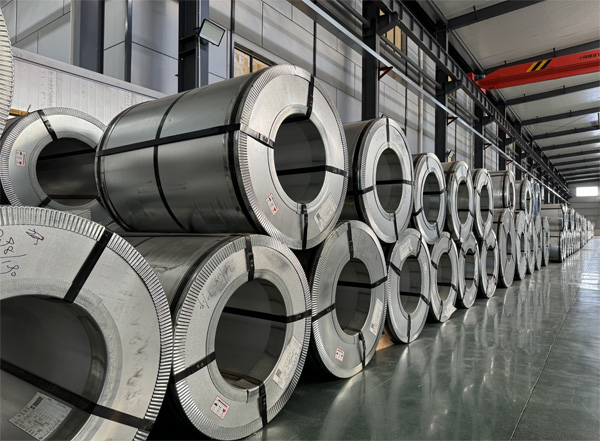Silicon steel coil is a highly specialized type of steel that is indispensable in the manufacturing of electrical equipment, particularly in the production of transformers, motors, and electrical generators. Also known as electrical steel, silicon steel is renowned for its magnetic properties and its ability to efficiently conduct electricity while minimizing energy losses. The addition of silicon to steel enhances its electrical and mechanical properties, making it a crucial material in the modern electrical and power industries.
The silicon in the steel significantly improves its electrical conductivity and reduces energy losses in alternating current (AC) magnetic circuits. This makes silicon steel coils ideal for applications where electrical efficiency is critical. The material is commonly produced in coil form, allowing it to be easily rolled, shaped, and stamped into various components used in electrical machinery.
The production of silicon steel coils involves a detailed and precise manufacturing process that ensures the material’s high performance in electrical applications. The general process includes the following steps:
Silicon steel is made by combining iron with a controlled amount of silicon during the steelmaking process. Silicon levels are carefully controlled because higher levels of silicon increase the material’s magnetic properties, but they also reduce its mechanical strength. The steel is then cast into slabs or sheets, which are processed into coils.
The steel sheets or slabs are subjected to a rolling process, which helps reduce their thickness and increase their surface area. This is typically done through hot rolling, followed by cold rolling, which helps to further refine the steel's properties and ensures it can be formed into thin sheets (typically 0.35mm to 0.50mm thick).
After rolling, the silicon steel undergoes an annealing process in a controlled atmosphere to remove internal stresses and improve its magnetic properties. Annealing also helps achieve the desired crystalline structure within the steel, which is essential for maximizing the material’s magnetic permeability and reducing core loss during operation.

A final step in the production of silicon steel coils is the application of a thin coating, usually an insulating layer, to the surface. This coating helps prevent the steel from corroding and reduces eddy current losses, which are undesirable in electrical applications. Common coatings include varnishes or oxide layers, depending on the intended use.
The coils of silicon steel are then cut to size and shaped to meet the specifications required for different components, such as transformer cores, motor stators, or rotor laminations. The coils are typically available in various grades, depending on the performance requirements.
Silicon steel coils offer several distinct advantages that make them ideal for use in electrical applications:
One of the primary benefits of silicon steel is its high magnetic permeability, which means that it can efficiently conduct magnetic fields with minimal energy loss. This property is essential in electrical machines like transformers and motors, where efficient magnetic flux management is critical.
Silicon steel coils are designed to minimize core loss, which refers to the energy lost as heat during the magnetization and demagnetization cycles of alternating current (AC). By reducing these losses, silicon steel enhances the overall energy efficiency of electrical devices, particularly transformers, where core loss can be significant.
Due to their magnetic properties, silicon steel coils improve the electrical efficiency of devices such as motors and transformers by reducing energy dissipation. The lower the core loss, the more efficiently these devices can operate, translating into lower energy consumption and cost savings over time.
Silicon steel coils can be tailored to different grades and thicknesses, allowing them to be used in a variety of applications. From high-frequency electrical applications like power transformers to low-frequency industrial machinery, silicon steel is adaptable to a wide range of needs.
Silicon steel coils have excellent mechanical properties and resistance to wear, ensuring that components made from this material, such as transformers and motors, have a long operational life. The insulation coatings applied during manufacturing also help protect the material from corrosion and environmental factors.
The primary application of silicon steel coil is in the electrical industry, where its magnetic properties and energy-efficient characteristics are indispensable. Some of the most common applications include:
One of the most significant uses of silicon steel coils is in the cores of transformers, which are essential for stepping voltage levels up or down in electrical power transmission and distribution systems. Silicon steel’s high magnetic permeability and low core loss ensure that transformers operate efficiently with minimal energy dissipation.
Silicon steel coils are used in the stator and rotor laminations of electric motors, where their ability to conduct magnetic fields efficiently is crucial for generating mechanical motion. Motors used in industrial machinery, HVAC systems, and household appliances rely on silicon steel for their performance.
Similarly, generators that convert mechanical energy into electrical energy also use silicon steel coils in their design. The high efficiency of silicon steel contributes to the overall performance and reliability of generators, especially in large-scale power generation facilities.
 +86-523 8891 8899
+86-523 8891 8899  +86-523 8891 8266
+86-523 8891 8266  info@tl-core.com
info@tl-core.com  No.1, Third Industrial Park, Liangxu Street, Taizhou City, Jiangsu, China
No.1, Third Industrial Park, Liangxu Street, Taizhou City, Jiangsu, China 

 English
English Español
Español Türk
Türk 中文简体
中文简体